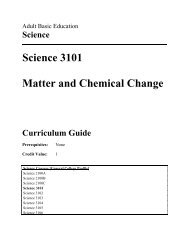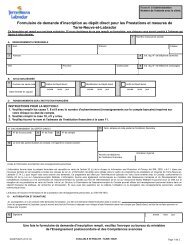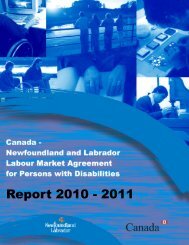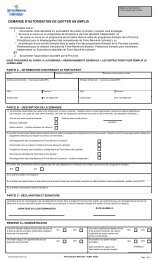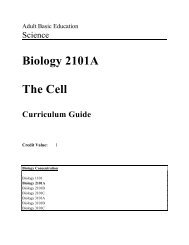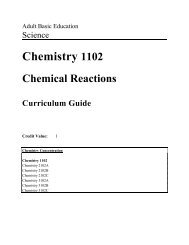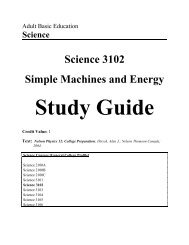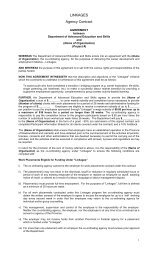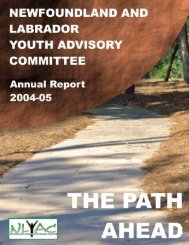English 3101A - Department of Advanced Education and Skills
English 3101A - Department of Advanced Education and Skills
English 3101A - Department of Advanced Education and Skills
Create successful ePaper yourself
Turn your PDF publications into a flip-book with our unique Google optimized e-Paper software.
Adult Basic <strong>Education</strong><strong>English</strong> Language Arts<strong>English</strong> <strong>3101A</strong>Curriculum GuidePrerequisites: <strong>English</strong> 2101A, 2101B, 2101CCredit Value: 1Required <strong>English</strong> Courses[Degree <strong>and</strong> Technical Pr<strong>of</strong>ile <strong>and</strong> Business-Related College Pr<strong>of</strong>ile]<strong>English</strong> Language Arts 1101A<strong>English</strong> Language Arts 1101B<strong>English</strong> Language Arts 1101C<strong>English</strong> Language Arts 2101A<strong>English</strong> Language Arts 2101B<strong>English</strong> Language Arts 2101C<strong>English</strong> Language Arts <strong>3101A</strong><strong>English</strong> Language Arts 3101B<strong>English</strong> Language Arts 3101C
Table <strong>of</strong> ContentsTo the Instructor ............................................................. 3General Learning Outcomes .................................................... 4Unit IUnit 2Unit 3Short Story <strong>and</strong> Related Writing ............................................ 5Novel <strong>and</strong> Related Writing ..................................................Written Communications <strong>and</strong> Writing Conventions ...............................Anthologies: Echoes 12Echoes 12 CDL<strong>and</strong>, Sea, <strong>and</strong> Time, Book ThreeReference Books:Reference PointsCanadian Students’ Guide to Language, Literature <strong>and</strong> MediaInstructor Resources:Echoes 12 Teacher’s ResourceL<strong>and</strong>, Sea, <strong>and</strong> Time, Book Three Teacher’s GuideRecommended Novels: See list <strong>of</strong> recommended novels, Unit 2.<strong>English</strong> <strong>3101A</strong> Curriculum Guide Page 3
To the Instructor<strong>English</strong> <strong>3101A</strong><strong>English</strong> <strong>3101A</strong> is the first in a series <strong>of</strong> three one-credit courses (<strong>English</strong> <strong>3101A</strong>, 3101B, <strong>and</strong>3101C) developed to be equivalent to the provincial high school’s Academic <strong>English</strong> 3201. Eachcourse in the series has three Units covering distinct elements <strong>of</strong> literature <strong>and</strong> language. <strong>English</strong><strong>3101A</strong> covers the short story <strong>and</strong> the novel in Units 1 <strong>and</strong> 2 respectively. Unit 3, “WrittenCommunications <strong>and</strong> Writing Conventions”, introduces précis writing <strong>and</strong> provides additionalinstruction <strong>and</strong> practice in writing formal letters. It also covers elements <strong>of</strong> punctuation (colon<strong>and</strong> semicolon) <strong>and</strong> parallel structure.New Approach for ABE <strong>English</strong><strong>English</strong> <strong>3101A</strong>, like all the new ABE <strong>English</strong> courses, combines language <strong>and</strong> literature. This isin contrast to the program which these new courses replace, where language <strong>and</strong> literature havebeen taught as completely separate courses <strong>and</strong> students have not necessarily had to studyliterature to graduate. Increased exposure to literature <strong>and</strong> experience with reading should helpstudents become more pr<strong>of</strong>icient writers; it should also develop the reading <strong>and</strong> analysis skillswhich are critical to success in other areas <strong>of</strong> Adult Basic <strong>Education</strong> as well as in future postsecondarystudies. Speaking, listening <strong>and</strong> viewing are also emphasized throughout the new ABE<strong>English</strong> program as critical elements <strong>of</strong> communications <strong>and</strong> language arts.The new <strong>English</strong> program is developmental - each level <strong>of</strong> the program covers similar material,but with increasing complexity. This enables students to develop skills over a period <strong>of</strong> time. Itshould be noted that <strong>English</strong> courses at any given level do not have to be completed in order(A,B,C), although they normally would be - <strong>and</strong> both curriculum guides <strong>and</strong> study guidessometimes make notes or references on the assumption that the courses are being completed inorder. However, if there are opportunities for grouping students for the completion <strong>of</strong> particularcourses, students may benefit more by completing a particular course along with others than byfollowing the A, B, C order <strong>of</strong> courses.Study GuidesEach new ABE <strong>English</strong> course has guides for both the instructor <strong>and</strong> the students - a CurriculumGuide <strong>and</strong> a Study Guide. The Study Guides are written in a personal <strong>and</strong> accessible style <strong>and</strong> areintended to give students some degree <strong>of</strong> independence in their work. They contain all theRequired Work as well as Guidelines <strong>and</strong> Suggestions for the completion <strong>of</strong> the work.Instructors should note, however, that there is much material in the Curriculum Guides (Notes forTeaching <strong>and</strong> Learning) that is not included in the Study Guides, <strong>and</strong> this will have to beintroduced to students as needed, particularly where they start new topics.<strong>English</strong> <strong>3101A</strong> Curriculum Guide Page 5
To the InstructorCurriculum GuidesEach <strong>English</strong> curriculum guide begins with a list <strong>of</strong> general learning outcomes for the course.Instructors should familiarize themselves with these outcomes <strong>and</strong> refer back to them as needed.The general learning outcomes are broken down into specific learning outcomes for each Unit <strong>of</strong>the course. Both the general <strong>and</strong> specific learning outcomes are achieved through the completion<strong>of</strong> Required Work.All the <strong>English</strong> curriculum guides are organized in two sequential sets <strong>of</strong> columns, as follows:Learning Out comesThis column lists the specific learningoutcomes for the Unit in 3 categories:Outcomes for Reading <strong>and</strong> Viewing,Outcomes for Speaking <strong>and</strong> Listening, <strong>and</strong>Outcomes for Writing <strong>and</strong> Other Ways <strong>of</strong>RepresentingRequired WorkThis column contains a numbered list <strong>of</strong> thework required to be completed in order tomeet the specific learning outcomes.Students are also given this list <strong>of</strong> requiredwork in their Study Guides. Instructorsshould note that, although the RequiredWork is listed in the same order in bothGuides, the numbering system is differentbetween the Curriculum Guide <strong>and</strong> theStudy Guide.Notes for Teaching <strong>and</strong> LearningThis column provides explanations <strong>and</strong>information related to the required work<strong>and</strong>/or the resources. Instructors should findthis column especially helpful in planning forinstruction, assisting students with makingselections, <strong>and</strong> making the best use <strong>of</strong> theavailable resources.Suggestions for AssessmentThis column provides information related tothe use <strong>of</strong> the resources for the assessment <strong>of</strong>learning outcomes. It also provides moregeneral suggestions <strong>and</strong> guidelines forassessment.Instructors should note that all the Required Work in reading, writing, speaking, researching, etc.includes assigned “Study” material. This is intended for the use <strong>of</strong> both the student <strong>and</strong> theinstructor. It is intended that instructors would use this material (as well as any other materialthey might choose) to introduce a particular topic to one or more students - following whichstudents would read the material on their own. Throughout both the curriculum guides <strong>and</strong> thestudy guides, group instruction <strong>and</strong> group discussion are encouraged.Page 6 Curriculum Guide <strong>English</strong> <strong>3101A</strong>
To the InstructorResourcesAnthologies, reference books, <strong>and</strong> instructor resources for this course are listed on the Table <strong>of</strong>Contents page (page 2). Instructors may supplement these resources, as they deem appropriate. Itshould be noted that instruction <strong>and</strong> practice in Writing Conventions (Unit 3) may require theuse <strong>of</strong> reference books <strong>and</strong> instructional resources from all levels <strong>of</strong> the <strong>English</strong> program. Thesemay not be included in the list <strong>of</strong> resources for the course. However, they are listed in the Notesfor Teaching <strong>and</strong> Learning, Unit 3.Note: Lists <strong>of</strong> recommended novels, non-fiction books, <strong>and</strong> longer plays are included in therelevant Units <strong>of</strong> the curriculum guides.Recommended EvaluationCourse Work* 20%Assignments** 30%Final Exam (entire course) 50%100%The overall pass mark for the course is 50%*Course work includes answers to questions on assigned reading, participation in discussions,notes taken on assigned study material, practice exercises on writing conventions, <strong>and</strong> any otherRequired Work which would not be classified as an Assignment.**Assignments include all the print, oral or multimedia texts which students are responsible forplanning <strong>and</strong> creating. Throughout the <strong>English</strong> program, this would include essays <strong>and</strong> researchpapers, reports, book reviews, formal correspondence, oral presentations, résumés, posters, etc.It would be appropriate for final examinations to include:•dem<strong>and</strong> reading <strong>and</strong> viewing <strong>of</strong> material which has not previously been studied;•dem<strong>and</strong> writing based on the longer works (drama, fiction, non-fiction) studied in the course; <strong>and</strong>•dem<strong>and</strong> writing based on the Written Communications component <strong>of</strong> the course, whereapplicable.Instructors may use the provincial public examination for Level 3 academic <strong>English</strong> as a guide forthe creation <strong>and</strong> grading <strong>of</strong> exams. Sample exams <strong>and</strong> grading st<strong>and</strong>ards may be viewed at thefollowing <strong>Department</strong> <strong>of</strong> <strong>Education</strong> web page:http://www.ed.gov.nl.ca/edu/k12/pub/courses/english3201.htm<strong>English</strong> <strong>3101A</strong> Curriculum Guide Page 7
General Learning OutcomesComprehensive LearningOutcome for Reading <strong>and</strong>Viewing1. Students will be expected toselect, read <strong>and</strong> view withunderst<strong>and</strong>ing, interpret <strong>and</strong>respond personally <strong>and</strong> critically toa range <strong>of</strong> literature, information,media <strong>and</strong> visual textsGeneral Learning Outcomes forReading <strong>and</strong> Viewing Fiction1.1 Select texts to support learningneeds <strong>and</strong> range <strong>of</strong> special interests1.2 Read a variety <strong>of</strong> literary genres<strong>and</strong> modes representing a widegeographical <strong>and</strong> historical range1.3 Use the cueing systems <strong>and</strong> a variety<strong>of</strong> strategies to construct meaning inreading <strong>and</strong> viewing complex <strong>and</strong>sophisticated print <strong>and</strong> media texts1.4 Show the relationships amonglanguage, topic, purpose, context <strong>and</strong>audience1.5 Make connections between ownbeliefs <strong>and</strong> cultures <strong>and</strong> those reflectedin literary texts1.6 Analyze thematic connectionsamong texts <strong>and</strong> articulate anunderst<strong>and</strong>ing <strong>of</strong> the universality <strong>of</strong>themes1.7 Articulate <strong>and</strong> justify points <strong>of</strong> viewabout texts <strong>and</strong> text elements1.8 Examine how texts work to reveal<strong>and</strong> produce ideologies, identities <strong>and</strong>positions1.9 Examine how textual features help areader/viewer to create meaningComprehensive LearningOutcome for Speaking <strong>and</strong>Listening2. Students will be expected tospeak <strong>and</strong> listen to explore, extend,clarify <strong>and</strong> reflect; to communicateinformation <strong>and</strong> ideas effectively<strong>and</strong> clearly; <strong>and</strong> to interact withsensitivity <strong>and</strong> respect, consideringthe situation, audience <strong>and</strong> purpose.General Learning Outcomes forSpeaking <strong>and</strong> Listening2.1 Listen critically to analyze <strong>and</strong>evaluate concepts, ideas <strong>and</strong>information2.2 Ask discriminating questions toacquire, interpret, analyze, <strong>and</strong> evaluateideas <strong>and</strong> information2.3 Articulate, advocate <strong>and</strong> justifypositions on issues or texts in aconvincing matter, showing anunderst<strong>and</strong>ing <strong>of</strong> a range <strong>of</strong> viewpoints2.4 Adapt language <strong>and</strong> delivery toaudience <strong>and</strong> purpose in informal <strong>and</strong>formal contexts2.5 Reflect critically on <strong>and</strong> evaluateown <strong>and</strong> others’ uses <strong>of</strong> language,recognizing elements <strong>of</strong> verbal <strong>and</strong> nonverbalmessages2.6 Demonstrate how spoken languageinfluences <strong>and</strong> manipulates, <strong>and</strong> revealsideas, values <strong>and</strong> attitudes2.7 Address the dem<strong>and</strong>s <strong>of</strong> speakingsituations, making critical languagechoices, especially <strong>of</strong> tone <strong>and</strong> styleComprehensive LearningOutcome for Writing <strong>and</strong> OtherWays <strong>of</strong> Representing3. Students will be expected to usewriting <strong>and</strong> other ways <strong>of</strong>representing to explore, clarify, <strong>and</strong>reflect; to create texts, using avariety <strong>of</strong> forms for a range <strong>of</strong>audiences <strong>and</strong> purposes; use a range<strong>of</strong> strategies to develop effectivewriting <strong>and</strong> other ways <strong>of</strong>representing <strong>and</strong> to enhance theirclarity, precision <strong>and</strong> effectiveness.General Learning Outcomes forWriting <strong>and</strong> Other Ways <strong>of</strong>Representing3.1 Use writing <strong>and</strong> other ways <strong>of</strong>representing to explore, extend, <strong>and</strong>reflect on experiences with, <strong>and</strong> insightsinto, challenging texts <strong>and</strong> issues3.2 Use writing <strong>and</strong> other ways <strong>of</strong>representing to explore, extend, <strong>and</strong>reflect on values <strong>and</strong> attitudes3.3 Integrate information from manysources to construct <strong>and</strong> communicatemeaning3.4. Use the conventions <strong>of</strong> writtenlanguage accurately <strong>and</strong> consistently infinal products3.5 Use technology effectively to servecommunication purposes3.6 Make effective choices <strong>of</strong> language<strong>and</strong> techniques to enhance the impact <strong>of</strong>writing<strong>English</strong> <strong>3101A</strong> Curriculum Guide Page 9
Unit 1 Short Story <strong>and</strong> Related WritingOutcomes for Reading <strong>and</strong> ViewingFiction (Short Story)•Examine how specific text elements developtheme•Explore various perspectives on a theme•Analyze characterization– Analyze comparisons <strong>and</strong> contrasts betweencharacters, where applicable– Analyze character development, whereapplicable•Assess the narrator’s <strong>and</strong>/or writer’s viewpoint•Interpret title in relation to various elements <strong>of</strong>the text (setting, character development, theme,etc.)•Explore the context <strong>of</strong> time, place <strong>and</strong>circumstance to extend underst<strong>and</strong>ing•Analyze symbolism•Analyze stylistic techniques•Respond personally <strong>and</strong> critically to visualtextOutcomes for Speaking <strong>and</strong> Listening• Engage in discussion <strong>of</strong> complex textsRequired Work - Short StoryShort Story Study1. Study pages 138-160 <strong>of</strong> Reference Points11/12, “A Closer Look at Narrative Fiction”.Glossary <strong>of</strong> Literary Terms2. Review personal glossary <strong>of</strong> literary terms(fiction) <strong>and</strong> add the following terms:2.1 mood2.2 first person point <strong>of</strong> view2.3 third person point <strong>of</strong> view2.4 omniscient narrator2.5 limited omniscient narrator2.6 ironyIntroductory Short Story3. Listen to the recorded short story, “Going tothe Moon”, by Nino Ricci on the Echoes 12CD (Track 11).4. Read “Going to the Moon” (Echoes 12,pages 210 - 217).4.1 Discuss the story with the instructor or in asmall group organized by the instructor.4.2 Answer questions 1 - 4 on page 218.• Articulate verbally interpretation <strong>of</strong> literarytexts(Continued on following page)<strong>English</strong> <strong>3101A</strong> Curriculum Guide Page 11
Unit 1 Short Story <strong>and</strong> Related WritingOutcomes for Speaking <strong>and</strong> Listening(continued)•Listen critically to analyze <strong>and</strong> evaluatetechnique, meaning <strong>and</strong> effect <strong>of</strong> literary texts• Consistently demonstrate active listening <strong>and</strong>an ability to engage respectfully with others inconversation <strong>and</strong> discussionOutcomes for Writing <strong>and</strong> Other Ways<strong>of</strong> Representing• Write personal <strong>and</strong> critical responses toliterature <strong>and</strong> related visuals–Compose responses which arecomprehensive <strong>and</strong> coherent–Support interpretation <strong>of</strong> a text withappropriate references to the text• Apply elements <strong>of</strong> description <strong>and</strong> narration, asappropriate• Use different methods <strong>of</strong> expository development,as appropriateRequired Work (continued)Selecting <strong>and</strong> Reading Short Stories5. Select <strong>and</strong> read a minimum <strong>of</strong> 3 other shortstories from Echoes 12, Unit 3.5.1 Answer the questions on Meaning <strong>and</strong>Form <strong>and</strong> Style in the Responding section <strong>of</strong>each story selected.6. Select <strong>and</strong> read a minimum <strong>of</strong> 2 short fictiontexts from L<strong>and</strong>, Sea <strong>and</strong> Time, Book Three.6.1 Answer questions - provided from theL<strong>and</strong>, Sea <strong>and</strong> Time, Book Three Teacher’sGuide.Selected short stories should represent a geographic<strong>and</strong> historical range, as specified in General LearningOutcome 1.2 (Fiction <strong>and</strong> Poetry).Visuals - Study7. Study pages 245-248 <strong>of</strong> Reference Points11/12, “Photographs”.Viewing8. View <strong>and</strong> respond to a visual selected fromany source <strong>and</strong> relate it (either in writing ororally) to a short story studied in this Unit.Note: This may present an opportunity for twostudents to collaborate on preparing <strong>and</strong>presenting a short oral presentation.Page 12 Curriculum Guide <strong>English</strong> <strong>3101A</strong>
Unit 1 Short Story <strong>and</strong> Related WritingNotes for Teaching <strong>and</strong> LearningSelecting <strong>and</strong> Reading Short Stories1. Students should be encouraged to selectshort stories from both Echoes 12 <strong>and</strong> L<strong>and</strong>,Sea <strong>and</strong> Time, Book Three based on personalinterest. Instructors should note that L<strong>and</strong>, Sea<strong>and</strong> Time, Book Three does not list texts bygenre, so students will need guidance in theselection <strong>of</strong> short stories from this anthology.For a list <strong>of</strong> short stories, <strong>and</strong> a commentary oneach, see pages 37-39 in the L<strong>and</strong>, Sea <strong>and</strong>Time, Book Three Teacher’s Guide.Instructors should be aware that there isadditional material in the L<strong>and</strong>, Sea <strong>and</strong> TimeTeacher’s Guide to support teaching (AuthorInformation, Commentary).2. Students should be encouraged to re-readstories for different levels <strong>of</strong> underst<strong>and</strong>ing3. Students should be encouraged to read morethan the minimum required texts to extendtheir exposure to fiction <strong>and</strong> commitment to alifelong reading experience.Viewing4. Both Echoes 12 <strong>and</strong> L<strong>and</strong>, Sea <strong>and</strong> Time,Book Three provide visuals which are linked toshort fiction. If students are guided to select avisual which is linked to a story they arestudying, this will increase the educationalvalue <strong>and</strong> reduce the amount <strong>of</strong> work they arerequired to complete. Both Teacher’s Guidesalso provide background information onvisuals <strong>and</strong>, where they are linked to stories,there is support material for the linkage.Suggestions for AssessmentGeneral Assessment GuidelinesThrough completion <strong>of</strong> the Required Workfor this Unit, students will be working towardsthe attainment <strong>of</strong> the three categories <strong>of</strong>specific learning outcomes concurrently:Reading <strong>and</strong> Viewing, Speaking <strong>and</strong>Listening, <strong>and</strong> Writing <strong>and</strong> Other Ways <strong>of</strong>Representing.Instructors will find that the L<strong>and</strong>, Sea <strong>and</strong>Time, Book Three Teacher’s Guide <strong>and</strong>Echoes 12 Teacher’s Resource provide ampleresources for the assessment <strong>of</strong> outcomes. Ineach case, the organizing concept <strong>of</strong> both thetext <strong>and</strong> teacher’s resource is the achievement<strong>of</strong> those specific outcomes. Both providetools for the direct assessment <strong>of</strong> learningthrough reading <strong>and</strong> viewing, writing <strong>and</strong>representing, <strong>and</strong> speaking <strong>and</strong> listening.They also provide valuable materials forextension activities (author information,related visuals, etc.).Instructors will have to provide students withquestions on the short stories selected fromL<strong>and</strong>, Sea <strong>and</strong> Time, Book Three. They areprovided in the Teacher’s Guide, along with“Multi-Dimensional Exploration” activities.In general, assessment for this Unit shouldinclude:•asking students to read sections <strong>of</strong> storiesaloud to demonstrate their underst<strong>and</strong>ing <strong>of</strong>meaning <strong>and</strong> the conventions <strong>of</strong> prose writing(Continued on following page)<strong>English</strong> <strong>3101A</strong> Curriculum Guide Page 13
Unit 1 Short Story <strong>and</strong> Related WritingSuggestions for Assessment(continued)•asking students to answer questions <strong>and</strong>complete written exercises provided in thetexts <strong>and</strong> teacher resources•asking students to discuss the stories they arereading with the instructor <strong>and</strong>/or otherstudentsIt is important that students are able to:•include specific references to support theirinterpretations•reflect on their responses <strong>and</strong> interpretations,taking their own <strong>and</strong> others’ cultural contextsinto consideration•reflect upon themes <strong>and</strong> issues revealed inshort stories <strong>and</strong> continually examine theuniversality <strong>of</strong> issues that are part <strong>of</strong> thehuman condition•distinguish between fiction <strong>and</strong> non-fictionPage 14 Curriculum Guide <strong>English</strong> <strong>3101A</strong>
Unit 2Novel <strong>and</strong> Related WritingOutcomes for Reading <strong>and</strong> ViewingFiction (Novel)•Examine how specific text elements developtheme•Analyze characterization– Analyze the relationship between characters– Analyze comparisons <strong>and</strong> contrasts betweencharacters, where applicable– Analyze character development, whereapplicable•Assess the narrator’s <strong>and</strong>/or writer’s viewpoint•Interpret title in relation to various elements <strong>of</strong>the text (setting, character development, theme,etc.)•Explore the context <strong>of</strong> time, place <strong>and</strong>circumstance to extend underst<strong>and</strong>ing•Analyze symbolism•Analyze stylistic techniquesOutcomes for Writing <strong>and</strong> Other Ways<strong>of</strong> Representing• Write personal <strong>and</strong> critical responses toliterature–Compose responses which arecomprehensive <strong>and</strong> coherent–Support interpretation <strong>of</strong> a text withappropriate references to the textRequired Work - NovelNarrative Fiction ReviewReview: The study material completed for theshort story in Unit 1 <strong>of</strong> this course (Pages 138-160 <strong>of</strong> Reference Points, “A Closer Look atNarrative Fiction”) will also prepare studentsfor reading the novel. Unless the novel isstarted at the same time as the short stories,students should be encouraged to review thissection.Select, Read <strong>and</strong> Analyze a Novel1. Select <strong>and</strong> read a novel from the followinglist:•The Stone Angel (Margaret Lawrence)•Lord <strong>of</strong> the Flies (William Golding)•Schindler’s List (Thomas Keneally)•River Thieves (Michael Crummy)•The Afterlife <strong>of</strong> George Cartwright (JohnSteffler)(See Notes for Teaching <strong>and</strong> Learning, #6, forinformation on each <strong>of</strong> the recommendednovels.)1.1 Discuss the novel with the instructor or ina small group organized by the instructor.2. Complete content <strong>and</strong> comprehensionquestions on the novel. (See Suggestions forAssessment.)(Continued on following page)<strong>English</strong> <strong>3101A</strong> Curriculum Guide Page 15
Unit 2Novel <strong>and</strong> Related WritingOutcomes for Writing <strong>and</strong> Other Ways<strong>of</strong> Representing (continued)• Refine <strong>and</strong> edit writing, through severaldrafts, to ensure coherence <strong>and</strong> accuracyRequired Work (continued)Literary Essay Study3. Study pages 75-79 <strong>of</strong> Reference Points11/12, “Critical Writing <strong>and</strong> Literary Analysis”.Write a Literary Essay4. Compose a literary essay <strong>of</strong> at least 750words (approximately 3 typewritten pages,double-spaced), critically responding to thenovel. The literary essay should be constructedusing the student sample <strong>of</strong> literary analysis(page 78-79 <strong>of</strong> Reference Points11/12) as aguide.4.1 Use word processing s<strong>of</strong>tware to type thefinal draft <strong>of</strong> the literary essay.Page 16 Curriculum Guide <strong>English</strong> <strong>3101A</strong>
Unit 2Novel <strong>and</strong> Related WritingNotes for Teaching <strong>and</strong> LearningSelecting a Novel1. Within the recommended list <strong>of</strong> novels,students should be encouraged to select a novelbased on personal interest. The instructor willneed to ensure that students are aware <strong>of</strong> theways in which they might find out whether anovel is <strong>of</strong> interest to them. Students shouldbe aware <strong>of</strong> the kinds <strong>of</strong> information that maybe presented in or on the book itself (apromotional “blurb”; introduction; preface,chapter headings). Students should also beaware <strong>of</strong> the usefulness <strong>of</strong> book reviews <strong>and</strong>the possible sources for these (Internet,newspapers, magazines). Finally, studentsshould be encouraged to seek the views <strong>of</strong>others who have already read one or more <strong>of</strong>the novels or <strong>of</strong> somebody who has read anovel they are particularly interested in.List <strong>of</strong> Recommended Novels2. Instructors should note that the list <strong>of</strong> novelsis a list <strong>of</strong> recommendations. The list is notprovided to the student in the <strong>English</strong> <strong>3101A</strong>Study Guide, but must be presented to thestudent by the instructor. Instructors may addother novels to the list for students to choosefrom, but should use the following guidelinesin selecting other novels to add:–It must be a novel (not a non-fiction book).–It must have literary merit.–The reading level should be appropriate forthe course.(Continued on following page)Suggestions for AssessmentContent <strong>and</strong> Comprehension QuestionsInstructors will need to develop questions oneach <strong>of</strong> the novels. These questions shouldassess as many <strong>of</strong> the Outcomes for Reading<strong>and</strong> Viewing Fiction (Novel) as possible.Students should not be given questions on thenovel until they have read it completely atleast once. They should be guided to re-readsections, as needed, to answer the content <strong>and</strong>comprehension questions.Note: Instructors should be aware that most <strong>of</strong>the recommended novels appear on one ormore Internet web sites. Some publishers’web sites provide substantial backgroundinformation as well as teaching <strong>and</strong> learningmaterial. These may be very helpful, not onlyin providing additional learning material forstudents, but also in the development <strong>of</strong>assessment material.Literary EssayStudents should be required to write at leasttwo rough drafts <strong>of</strong> the literary essay revisingfor meaning <strong>and</strong> clarity <strong>and</strong> discussingchanges with the instructor as they do this.They should also be required to edit <strong>and</strong>pro<strong>of</strong>read the literary essay to correct anyerrors in spelling, grammar <strong>and</strong> punctuation.The essay should be assessed on the basis <strong>of</strong>the guidelines for literary analysis provided inReference Points 11/12, pages 75-76.<strong>English</strong> <strong>3101A</strong> Curriculum Guide Page 17
Unit 2Novel <strong>and</strong> Related WritingNotes for Teaching <strong>and</strong> Learning(continued)–The story should be <strong>of</strong> interest <strong>and</strong> relevanceto adults.Note: For information on the list <strong>of</strong>recommended novels, see #6 below.Reading the Novel3. Depending on the novel selected <strong>and</strong> theknowledge level <strong>of</strong> the student, instructors mayneed to provide an introduction to the novelbefore the student begins to read it. In somecases, an underst<strong>and</strong>ing <strong>of</strong> the context <strong>and</strong>/orbackground <strong>of</strong> the novel is critical tocomprehension from the very first page. Whereappropriate, students may be guided toundertake some background research prior tobeginning their reading <strong>of</strong> the novel.Suggestions for Assessment(continued)General Guidelines for AssessmentFor both the questions <strong>and</strong> the literary essay, itis important that students are able to:•include specific references to support theirinterpretations•reflect on their responses <strong>and</strong> interpretations,taking their own <strong>and</strong> others’ cultural contextsinto consideration•reflect upon themes <strong>and</strong> issues revealed in thenovel <strong>and</strong> continually examine the universality<strong>of</strong> issues that are part <strong>of</strong> the human condition4. Students should be encouraged to identify<strong>and</strong> re-read portions <strong>of</strong> the novel which may beeither critical to underst<strong>and</strong>ing the story ordifficult to comprehend.5. Where possible, students should be giventhe opportunity to discuss the novel with otherswho may be reading it or with the instructor.Page 18 Curriculum Guide <strong>English</strong> <strong>3101A</strong>
Unit 2Novel <strong>and</strong> Related WritingNotes for Teaching <strong>and</strong> Learning(continued)Information on Recommended Novels6. There are 5 novels recommended for thiscourse:Stone Angel by Margaret Lawrence (1964)This novel is told form the point <strong>of</strong> view <strong>of</strong> aninety year old woman named Hagar Shipleyfrom a Canadian prairie town. Through herreflections, we follow her life as a rebelliousbride <strong>and</strong> later a grieving mother, <strong>and</strong> wesympathize with her as she resists being movedinto a nursing home. The CBC’s CanadaReads website describes Hagar Shipley as “one<strong>of</strong> the most memorable characters in Canadianfiction”.Stone Angel is used in the provincial highschool curriculum.Schindler’s List by Thomas Keneally (1982)This novel is a work <strong>of</strong> fiction based on thetrue story <strong>of</strong> a German industrialist <strong>and</strong> warpr<strong>of</strong>iteer, Oskar Schindler, during World WarII <strong>and</strong> the Nazi occupation <strong>of</strong> Pol<strong>and</strong>.Schindler, who owned a factory, outwitted theNazis to protect his Jewish factory workers,thus saving over 1,100 Jews from the deathcamps. The novel is made up <strong>of</strong> a series <strong>of</strong>stories about different people, which take placeover a period <strong>of</strong> time.Schindler’s List is used in the provincial highschool curriculum.<strong>English</strong> <strong>3101A</strong> Curriculum Guide Page 19
Unit 2Novel <strong>and</strong> Related WritingNotes for Teaching <strong>and</strong> Learning(continued)Lord <strong>of</strong> the Flies by William Golding (1954)This novel is about a group <strong>of</strong> young boyswhose plane crashes on a deserted isl<strong>and</strong>.After a while surviving on the isl<strong>and</strong>, theybreak into two feuding b<strong>and</strong>s. Several <strong>of</strong> theboys revert to an uncivilized state, <strong>and</strong> cruelty<strong>and</strong> murder result.Lord <strong>of</strong> the Flies is used in the provincial highschool curriculum.River Thieves by Michael Crummey (2001)This is a fictional account <strong>of</strong> the extinction <strong>of</strong>the Beothuk Indians based on real historicalevents. Set in the early 1800s in the Exploitsregion <strong>of</strong> Newfoundl<strong>and</strong>, the novel focuses onDavid Buchan, the British naval <strong>of</strong>ficer whocame to Newfoundl<strong>and</strong> to establish friendlycontact with the Beothuk <strong>and</strong> the Peytons, afamily <strong>of</strong> settlers who were involved in the fate<strong>of</strong> the Beothuks.The Afterlife <strong>of</strong> George Cartwright by JohnSteffler (1992)This novel is based on the life <strong>of</strong> the Labradorexplorer, Captain George Cartwright, wholived in Labrador between 1768 <strong>and</strong> 1786 <strong>and</strong>kept a journal <strong>of</strong> his experiences there. Theauthor uses some <strong>of</strong> Cartwright’s actualjournal entries mixed with his own fictionalones to create a fascinating story <strong>of</strong> life inLabrador in the eighteenth century.Page 20 Curriculum Guide <strong>English</strong> <strong>3101A</strong>
Unit 3Written Communications <strong>and</strong> Writing ConventionsOutcomes for Written Communications<strong>and</strong> Writing Conventions• Express a writer’s ideas in own words• Interpret ideas expressed in prose• Summarize clearly <strong>and</strong> concisely• Use different forms <strong>of</strong> writtencommunication, as appropriate• Tailor written presentation to purpose <strong>and</strong>intended audience• Refine <strong>and</strong> edit writing, through severaldrafts, to ensure accuracy <strong>and</strong> consistency• Design texts that are aesthetically pleasing<strong>and</strong> appropriate to the purpose•Use the conventions <strong>of</strong> written languageaccurately <strong>and</strong> consistently in final product•Use technology effectively to servecommunication purposesRequired WorkPrécis Study1. Study pages 28-30 <strong>of</strong> Reference Points11/12, “Learning by Writing a Précis”.Reading to Write a Précis2. Read the following in preparation for writinga précis:2.1 “The Development <strong>of</strong> the <strong>English</strong>Language”, Appendix C, Reference Points11/12 (Pages 373-386)2.2 “History <strong>of</strong> the <strong>English</strong> Language”,Chapter 10, Guide to Language, Literature,<strong>and</strong> Media (Pages 338-355)Write a Précis3. Choose one <strong>of</strong> the two above readings <strong>and</strong>write a précis.Formal Correspondence4. Review Reference Points 11/12, Pages 303-307.5. Write a minimum <strong>of</strong> two formal letters inthe appropriate format. Formal letters shouldinclude:5.1 A letter requesting somebody to write areference letter to support a job application5.2 A letter <strong>of</strong> acknowledgment in response5.3 Use word processing s<strong>of</strong>tware to type thefinal draft <strong>of</strong> each letter.<strong>English</strong> <strong>3101A</strong> Curriculum Guide Page 21
Unit 3Written Communications <strong>and</strong> Writing ConventionsOutcomes for Written Communications<strong>and</strong> Writing Conventions (continued)Required Work (continued)•Demonstrate underst<strong>and</strong>ing <strong>of</strong> complexgrammatical structures, precise <strong>and</strong> variedword choice, <strong>and</strong> complex <strong>and</strong> varied sentencestructures for the communication <strong>of</strong> ideasWriting Conventions6. Review the following areas <strong>of</strong> punctuation:•colon•semicolon(See Notes for Teaching <strong>and</strong> Learning.)6.1 Complete practice exercises in usingcolons <strong>and</strong> semicolons. (See Notes forTeaching <strong>and</strong> Learning.)7. Examine the use <strong>of</strong> parallel structure. (SeeNotes for Teaching <strong>and</strong> Learning)7.1 Complete practice exercises in usingparallel structure. (See Notes for Teaching <strong>and</strong>Learning)Page 22 Curriculum Guide <strong>English</strong> <strong>3101A</strong>
Unit 3Written Communications <strong>and</strong> Writing ConventionsNotes for Teaching <strong>and</strong> LearningPrécis Study1. Reference Points 11/12 (pages 28-30)provides a very good explanation <strong>of</strong> thefunction <strong>of</strong> the précis in report writing <strong>and</strong>research essays. It also provides a clear stepby-stepprocedure for writing a précis <strong>and</strong> asample précis. Students may read thisindividually but, ideally, the instructor wouldpresent the material <strong>and</strong> supplement it withshort practice exercises.Précis Writing Assignment2. The précis writing assignment is based ontwo reports on the development <strong>of</strong> the <strong>English</strong>language. Students are required to read both,from which they will select one to create aprécis. The reports differ in style <strong>and</strong>complexity but each has particular advantagesin terms <strong>of</strong> the précis writing exercise. It isimportant that students complete both readingsbefore making their choice.Formal Letters3. Students will have studied Reference Points11/12 (pages 303-307) in <strong>English</strong> 2101A. Theyshould be encouraged to review it prior towriting their letters for this course. Instructorsshould be aware that Reference Points givesonly one format for formal letters - full blockformat. It is recommended that students beencouraged to perfect this format <strong>and</strong> use it tothe exclusion <strong>of</strong> all others.Suggestions for AssessmentPrécisThe précis should be assessed in terms <strong>of</strong> theextent to which students have followed the 10-step process outlined in Reference Points11/12, page 28-29. In particular, Steps 4-10could be used as an assessment checklist. Theprécis should be, as Step 10 states, “acoherent, smooth-flowing composition withadequate transition between ideas. The ideasshould flow in the same order as the original”.The précis <strong>of</strong> the selected article should beapproximately one-third the length <strong>of</strong> theoriginal article.Formal CorrespondenceAt this level, students should be expected toadhere strictly to the conventions <strong>of</strong> theprescribed format for formal correspondence.The main focus <strong>of</strong> the assessment <strong>of</strong> theircorrespondence should be the extent to whichit achieves its purpose. In particular, thefollowing should be assessed:–accuracy–conciseness–tone–language<strong>English</strong> <strong>3101A</strong> Curriculum Guide Page 23
Unit 3Written Communications <strong>and</strong> Writing ConventionsNotes for Teaching <strong>and</strong> Learning(continued)Suggestions for Assessment(continued)Writing Conventions4. Students at this level should have masteredthe fundamentals <strong>of</strong> writing conventions <strong>and</strong>terminology (including parts <strong>of</strong> speech,sentences, verb tenses, end punctuation, <strong>and</strong>subject-verb agreement). However, studentswho demonstrate weakness in thesefundamentals should be required to dostructured review <strong>and</strong> practice.Instruction in writing conventions should beapproached as direct teacher-to-studentinstruction as far as possible. Grouping <strong>of</strong>students should also be used as far as possiblein order to facilitate meaningful discussion <strong>of</strong>the conventions being taught. Students doing<strong>English</strong> <strong>3101A</strong> may be grouped with studentsdoing <strong>English</strong> 3102A for instruction inwriting conventions, as they are studying thesame material.Writing ConventionsInstructors should always use some kind <strong>of</strong>diagnostic measure to determine whetherstudents need instruction <strong>and</strong> practice in anyaspect <strong>of</strong> writing conventions. This willnormally be done through examining students’writing but, in some cases, it may be donethorough the use <strong>of</strong> a pre-test.Although student performance on practiceexercises <strong>and</strong> summative tests in writingconventions will be considered for a portion <strong>of</strong>the grade in this section <strong>of</strong> <strong>English</strong> <strong>3101A</strong>, theprimary focus <strong>of</strong> assessment for gradingpurposes should be on the application <strong>of</strong>writing conventions in the finished work.Students should not be expected to completepractice exercises on any element <strong>of</strong> writingconventions without having first had therelevance <strong>of</strong> the component to their writingexplained <strong>and</strong> demonstrated by the instructor.While efforts have been made to select themost appropriate reference texts, no text canprovide sufficient explanation for the studentsto make the necessary connection to their ownwriting.Page 24 Curriculum Guide <strong>English</strong> <strong>3101A</strong>
Unit 3Written Communications <strong>and</strong> Writing ConventionsNotes for Teaching <strong>and</strong> Learning(continued)5. Required Work 6 has students examine theuse <strong>of</strong> the colon <strong>and</strong> semi-colon. Explanationsfor colons <strong>and</strong> semicolons can be found inResource Lines 9/10 (pages 335-336), Guide toLanguage, Literature <strong>and</strong> Media (page 149)<strong>and</strong> Reference Points (pages 352-353; 365). Itis recommended the material in these texts beused as the basis <strong>of</strong> direct instruction with agroup <strong>of</strong> students.For Required Work 6.1, students will need topractice using the colon <strong>and</strong> semicolon. Whileany good language reference text may providepractice exercises in this, the following maybe recommended from the ABE <strong>English</strong>resource materials:“Colons”, Passages 12 Language Master 24“Colons ”, Communicate! Blackline Master5-13“Colon”, Crossroads 10 Language Master 39“Semicolon”, Crossroads 10 LanguageMaster 36“Semicolons”, Passages 12 Language Master246. Required Work 7 has students examine theuse <strong>of</strong> parallel structure. Explanations <strong>of</strong>parallel structure can be found in ReferencePoints (pages 357-358), <strong>and</strong> Communicate!(pages 87-88). It is recommended that thematerial in these texts be used as the basis <strong>of</strong>direct instruction with a group <strong>of</strong> students.(Continued on following page)<strong>English</strong> <strong>3101A</strong> Curriculum Guide Page 25
Unit 3Written Communications <strong>and</strong> Writing ConventionsNotes for Teaching <strong>and</strong> Learning(continued)For Required Work 7.1, students will need topractice using parallel structure. While anygood language reference text may providepractice exercises in this, the following may berecommended from the ABE <strong>English</strong> resourcematerials:“Parallelism”, Communicate! BlacklineMaster 4-17“Parallelism <strong>and</strong> Subject-Verb Agreement”,Communicate! Blackline Master 4-17“Parallel Structure”, Passages LanguageMaster 11Page 26 Curriculum Guide <strong>English</strong> <strong>3101A</strong>




